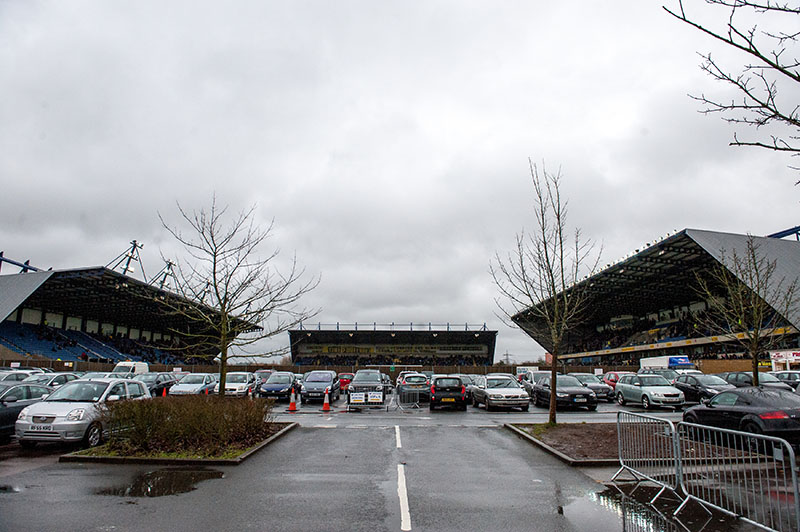
There’s not always the luxury of more time if a new ground isn’t quite ready – and whether they end up dodging raindrops or piles of rubble, it’s usually the fans that suffer
3 June ~ The front-row seats at Spurs’ new home are closer to the pitch than at any other top-flight stadium, and there’s a steep dip close to the touchline. So the subject of whether it would be possible to deliver effective corners was widely discussed ahead of the first competitive matches there. Thus far, although the margins for space are certainly tight, there doesn’t appear to be a major flaw (as was suggested in several quarters) with the new ground; players haven’t tumbled haplessly down into the advertising hoardings, or run out of space when taking corners. Yet structural faults have been part and parcel of football’s new constructions for decades.
The Maracanã Stadium in Rio de Janeiro – constructed specifically for the 1950 World Cup – had an official capacity of 183,000, making it the largest football ground in the world. Even as huge crowds flocked to it throughout the tournament, the Maracanã remained a building site. Piles of rubble and materials were left unattended as supporters surged past poorly constructed barriers and tiptoed their way over unfinished walls at the back of the stadium to ensure they saw Brazil play their group matches.
The hosts were even aided by the partly unfinished ground. Due to the incomplete drainage system, stadium officials installed a temporary raised wooden floor following flooding, in order that players’ feet weren’t soaked in the depths of the new ground. Yugoslavia player Rajko Mitic proceeded to smack his head on a dangling iron girder before a match against the hosts, resulting in medical treatment and his team starting the match with ten men.
As Brazil prepared to host the World Cup again in 2014, organisers admitted that the roof at São Paulo’s Itaquerão Stadium would not be completed in time for the tournament. A month before the World Cup began, the venue underwent its final test by hosting a Brazilian league match between Corinthians and Figueirense, which was marred by torrential rain and hailstorms, forcing many of the restricted 40,000 crowd not under the cover of the roof’s inner liner to seek shelter elsewhere. “The scramble to stay dry could have been a danger for fans. Let’s hope that the weather is kinder to us throughout the World Cup,” said a stadium official. The roof at the Itaquerão, which hosted England v Uruguay, was finally completed two years later.
In England, grandiose stadium plans have occasionally backfired. When Carlisle United opened their impressive new East Stand back in 1996, ebullient chairman Michael Knighton vowed to transform Brunton Park into a 25,000 all-seat ground surrounded by a bowling alley, hotel and restaurants. Future building work, Knighton insisted, would see the rest of the ground, and the pitch, move with the East Stand, which sat slightly to the North. The subsequent building work never happened, which means that the East Stand still overlaps the pitch by 21 metres, giving Brunton Park a distinctly asymmetrical appearance. It remains one of the oddest sights in English football, although chairman Andrew Jenkins claimed in 2016: “It’s skewiff, but we’ve sort of got used to it.”
In the 1940s, ambitious Port Vale chairman Alderman Holdcroft vowed to build a super stadium holding 70,000 supporters. The “Wembley of the North” never materialised, due to the state of both the club and the country. “Holdcroft could not make Vale a wealthy club, nor could he divert sufficient materials from post-war rebuilding efforts,” wrote Simon Inglis in The Football Grounds of England and Wales. As a result, for many years the main stand had a grandiose yet unfinished feel to it. An open, windswept terrace was divided down the middle by a grand players’ entrance, lined in gleaming white concrete. The original foundations for the planned centrepiece main stand lay in place for many years, giving Vale Park an almost ghostly feel.
On a practical level, defective or incomplete stadiums can pose real problems for supporters and players. Those present for matches at the new National Stadium in Singapore in 2014 bemoaned the leaking roof which saw one of the stands flood, and the pitch which disintegrated during a Brazil v Japan friendly. Oxford United’s three-sided Kassam Stadium has been widely criticised by U’s supporters for its dissipated atmosphere and the wind which often howls around the ground on a matchday.
For event organisers, club owners and chairmen, problems with new constructions can lay waste to awe-inspiring plans, and even leave a permanent stain on their tenure. Jon Spurling
Photo by Simon Gill/WSC Photos: Oxford United’s three-sided Kassam Stadium
This article first appeared in WSC 387, June 2019. Subscribers get free access to the complete WSC digital archive – you can find out more here
